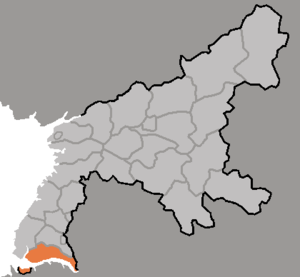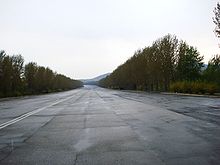Namp'o
| Namp'o
|
|
|---|---|
| Chosŏn'gŭl : | 남포 특별시 |
| Hancha : | 南浦 特別 市 |
| McCune-Reischauer : | Namp'o T'ŭkpyŏlsi |
| Revised Romanization : | Nampo Teukbyeolsi |
| Basic data | |
| Surface: | 82.9 km²
|
| Residents: | 450,723 (as of January 1, 2005) |
| Population density : | 5,437 inhabitants per km² |
Namp'o is a port city in North Korea with 450,723 inhabitants, making it the third largest city in the country. It is an industrial city, transport hub, cultural center with university, theater and museums.
geography
Namp'o is located on the west coast of North Korea, 55 kilometers southwest of Pyongyang at the mouth of the Taedong . The geographical coordinates are 38 ° 44 ' N , 125 ° 24' O .
The city consists of the municipality of Namp'o itself, as well as the following earlier counties from the province of Pyŏngan-namdo :
- Kangsŏ-gun ( 강서 군 ; 江西 郡 )
- Taean-gun ( 대안 군 ; 大 安郡 )
- Onch'ŏn-gun ( 온천군 ; 溫泉 郡 )
- Ryonggang-gun ( 룡 강군 ; 龍岡 郡 )
- Ch'ŏllima-gun ( 천리마 군 ; 千里馬 郡 )
history
The city's economic growth began in 1897 when the port opened to foreign trade.
From 1910 to 1945 Korea was part of the Japanese Empire . Until the end of this period, the city was called Chinnampo ( Japanese 鎮 南浦 ). The current name is derived from it.
The city was badly damaged in the Korean War (1950–1953) and after the war it became a center of the glass and shipbuilding industry.
From 1980 to 2004 Namp'o was a city under central government administration. In 2004 it became part of P'yŏngan-namdo and had the status of a special city within the province, which meant, among other things, that it continued to be under central administration. In 2010 it was spun off from the province again.
Culture and sights
The West Sea dam , built between 1981 and 1986, with a 15-kilometer-long dam and three large locks for ships up to 50,000 gross tons is located near the city . There is a beautiful beach near the dam.
A popular excursion spot in the area is Taesong Lake. This lake was artificially created in 1959 and is used to irrigate the fields in the area. Nearby is the Pyongyang golf course.
The mausoleums of Kangso and Tokhung-ri are also worth seeing . Kangso is northeast of Taesong Lake and 28 kilometers southwest of Pyongyang. Tombs of the Goguryeo dynasty (37 BC – 668 AD) from the 7th century were excavated there. In Tokhung-ri, three graves from the Koguryo dynasty were restored in 1976 and 1977, the year of which is dated to 408 AD.
Closer to Namp'o, to the west of the city, is the Waudo peninsula . There are a number of sports and leisure opportunities as well as a viewing pavilion.
Economy and Infrastructure
In the city there are shipyards , mechanical engineering, non-ferrous metallurgy ( Ch'ŏllima steel works ) and the glass industry. Fishing is an important source of income for Namp'o. The city is an important transport hub with roads, railways and ports. It is a center for reclamation from the sea. At the end of the 19th century, the port was opened for export , which led to an accelerated development of the economy and population growth.
Namp'o was and is a strategically important point for the regime in North Korea as a traffic artery and port for the capital and not least as a bastion against possible invaders who want to head towards Pyongyang. At the same time, the estuary at which Namp'o lies was also chosen for a large dam. Important parts of the North Korean Navy are also stationed around the Taedong estuary .
The so-called West Sea Dam serves primarily to separate sea and river water, as a fast road and rail link between the north and south banks of the Taedong, and as a physical barrier at the mouth of the river. It protects the region from possible flood disasters up to Pyongyang, serves to provide fresh water for industry and to supply the region with drinking water. Two billion cubic meters of water are pumped each year. The dam is not used to generate electricity .
Several Hana Electronics offices are located in Namp'o.
traffic
The Namp'o trolleybus serves two lines on weekdays, but only irregularly.
In the crisis years 1998 to 2000, the road from Pyongyang to Namp'o was expanded into an eight-lane motorway. An estimated 50,000 young volunteers laid the 43-kilometer road bed without the help of machines. To commemorate the project, which was completed after 700 days, the autobahn was renamed “ Street of Heroic Youth ”.
Individual evidence
- ↑ a b Kim So Yeol: North Korea Splits No. 38 and 39 Departments Up Again. In: Daily NK . February 15, 2011, accessed November 15, 2012 .
- ↑ http://www.nkeconwatch.com/category/dprk-organizations/companies/hana-electronics-company/
literature
- Christian Kracht, Eva Munz, Lukas Nikol: The total memory. Kim Jong Ils North Korea. Rogner & Bernhard, Berlin 2006. ISBN 3-8077-1020-5 .
- Arno Maierbrugger: North Korea Handbook. On the move in a mysterious land. Trescher, Berlin 2004, ISBN 3-89794-039-6
- Pang Hwan Ju, Hwang Bong Hyok: A Sightseeing Guide to Korea. Foreign Languages Publishing House, Pyongyang 1991
- Kim Sung Un: Panorama of Korea. Foreign Languages Publishing House, Pyongyang 1999
- Robert Willoughby: North Korea. The Bradt Travel Guide. Editions Bradt, Londres 2003, ISBN 1-84162-074-2
Web links
- Rainer Dormels: Nampo - the port of Pyongyang - the second largest city in the DPR Korea , 2014 (PDF; 855 kB)




